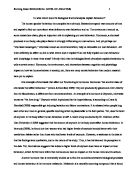The experimental features of the study
The experiment conducted by Rosenzweig and his colleagues involved male rats from different litters, which were randomly placed into two different environments; enriched and deprived. The rats placed in an enriched and stimulating environment were presented with several toys to play with, whereas rats placed in the enclosed deprived environment were exposed to no toys and a smaller cage. The rats spent from 30 to 60 days in their assigned environment before they were sacrificed. The brains of the rats were then dissected in order to analyze, weigh and measure the various sections of the brain to determine the amount of cell growth and the levels of neurotransmitter activity.
Through the post-mortem studies it was discovered that the rats which were placed in the enriched environment had an increased thickness of the cortex as well as more dendritic branching. It was also detected that the weight of the frontal lobe of these rats were heavier compared to the rats placed in the impoverished environment. The researchers also found that the synapses in the brain of the enriched rats were approximately 50% larger than in the deprived rats. This suggests that both perception and memory are improved. The researchers concluded that numerous aspects of the brain are changed by experience; when something new is learned, the neurons in the brain reconnect to create a new trace.
Strengths and limitations of the experimental method used
Although rats are considered to be the best model of inherited human diseases, as they share about 99% of their genes with humans, it is still not ascertain that the experimental outcome will be the same for humans as it is, among other things, unethical to involve human beings in an experiment of this type. It can also be questioned why only male rats were used in the experiment; this can therefore not be generalized that the same effect will be present in female rats.
The strengths of this study are that it is more efficient to use rats in these types of studies. Rats have a high reproductive ability as well as having large litters; it is therefore not time consuming when using rats in experimental studies. Another reason to why rats were used is because of their simplistic brain structure, in comparison with higher animals such as humans, the brain structure of a rat is not complex and therefore it is easier to examine and measure the brain structure of a rat as opposed to higher animals. It should also be noted that the post-mortem examinations were done in random order by code number, this is so that the person performing the autopsy would not know which rat was placed in which environment.
However, studies involving musicians indicates that there might be a correlation between environmental stimulation and cortical thickness. The result obtained from this experiment can therefore only be applied and generalized to humans in some extent. The human brain differs quite vastly compared to the brain of rodents, such as in genetic make-up and environmental inputs. It is therefore difficult to determine what an enriched environment is to different human beings.
Conclusion and evaluation
It was concluded from this experiment that the anatomy as well as the chemistry of the brain was altered by the environment which the enriched rats were placed in. The result of the experiment justified Rosenzweig’s argument prior to the experiment; the living environment of an animal does affect the development of its brain. The frontal lobe and the cerebral cortex of the rats living in the enriched environment were increased in both thickness and weight, suggesting that memory, perception and learning were improved in these rats. Even though research regarding neuroplasticity is still at its early stage, it has been proven mainly by Rosenzweig that one’s environment plays an essential role in intellectual development and the development of the brain.
Other findings showed that the ratio of RNA and DNA was greater in the enriched rats. These two brain chemicals are mainly important in cell growth, implying that the chemical activity was higher in these rats. Evidence from this study implicates that the environment has an effect on the development of the brain and that high stimulation lead to the occurrence of dendritic branching every time something new is learned. Though, it is not possible to conduct an experiment involving humans to test the hypotheses if an enriched environment has a beneficial effect in learning and the development of the brain whereas a deprived environment will have negative effect on the brain. It can therefore be concluded that Rosenzweig’s study is genuine but it can only be applied to human beings to some extent. Although, if an increasement of dendritic branching occurs every time something is learned, then the findings obtained from the studies involving animals showing how the brain is altered when responding to an environmental stimulation are of great importance for future studies and experiments.







